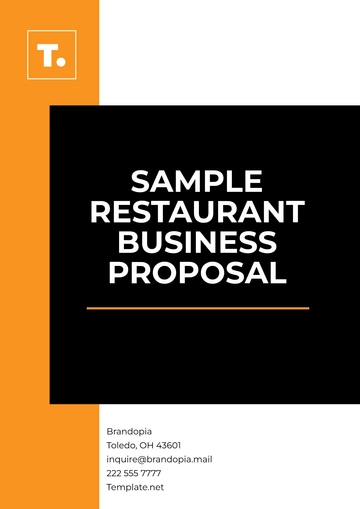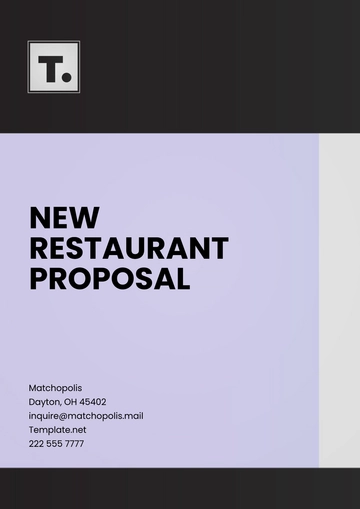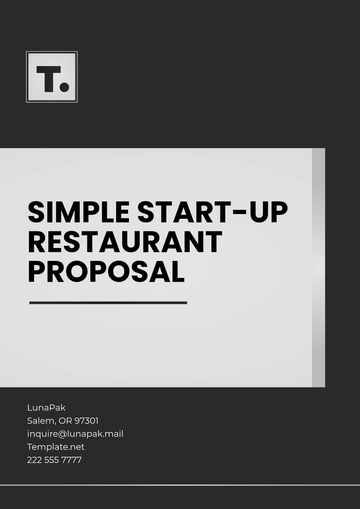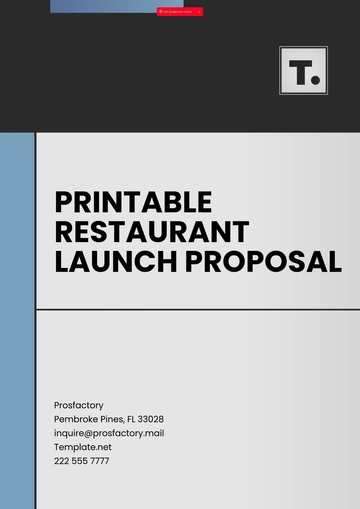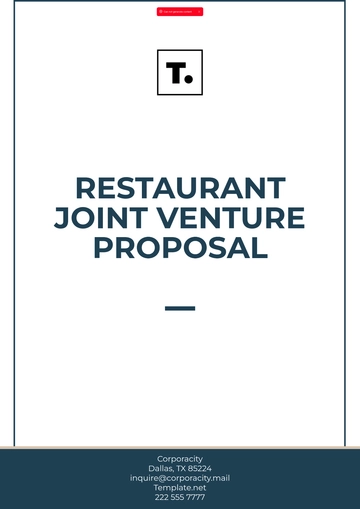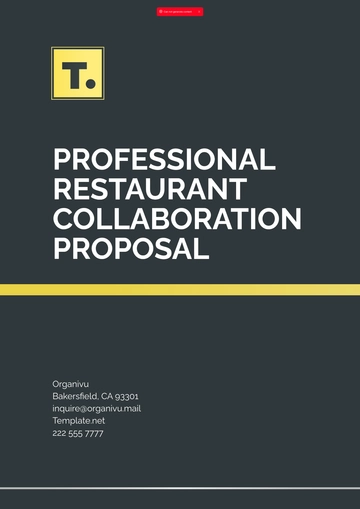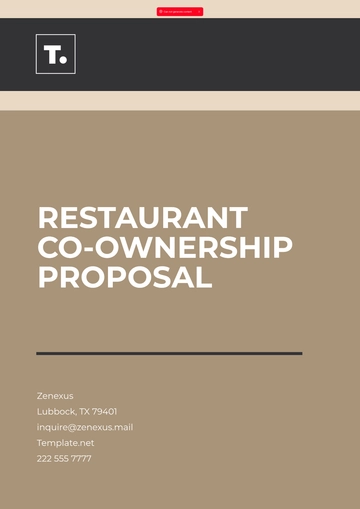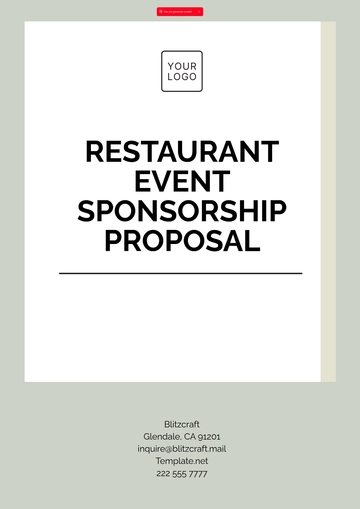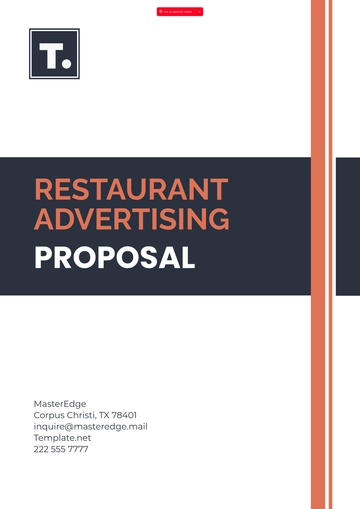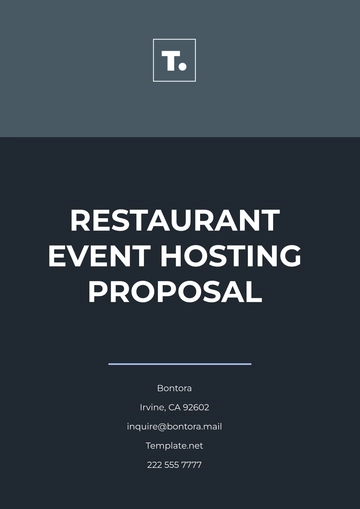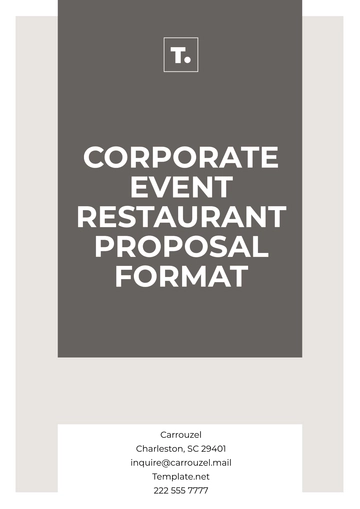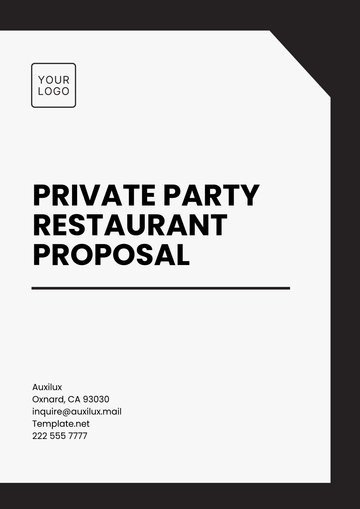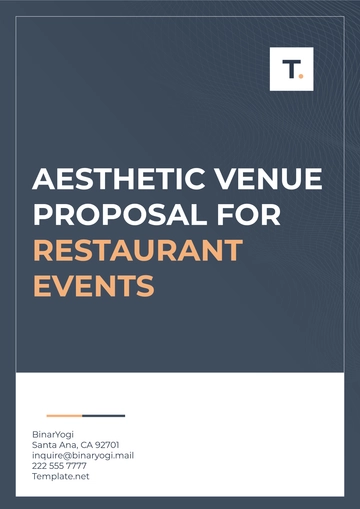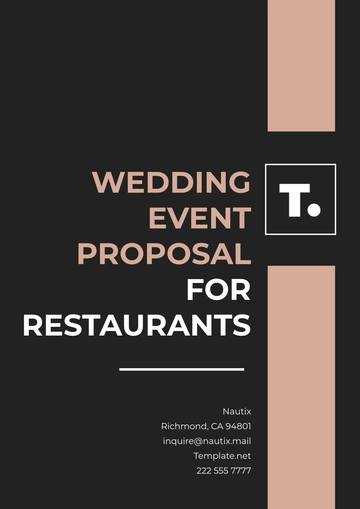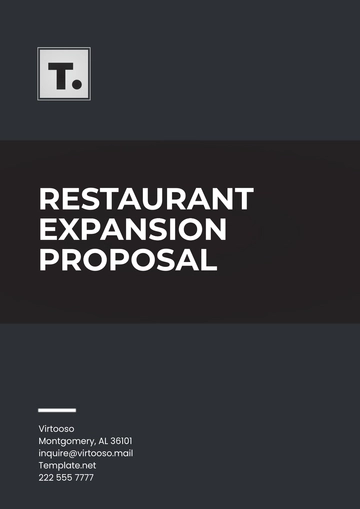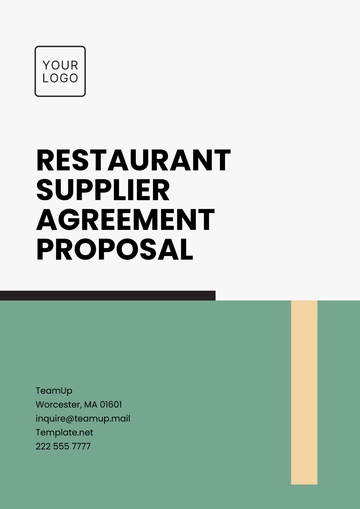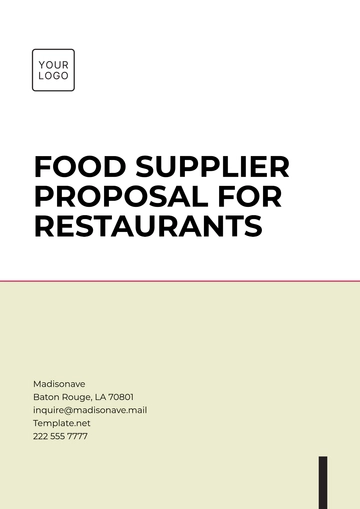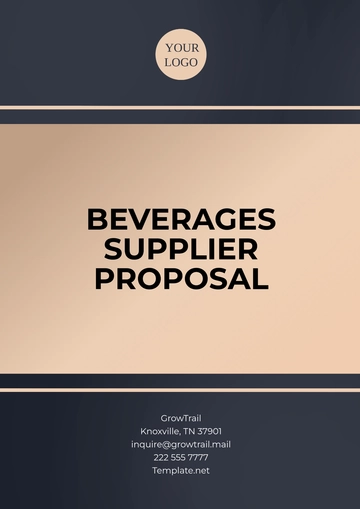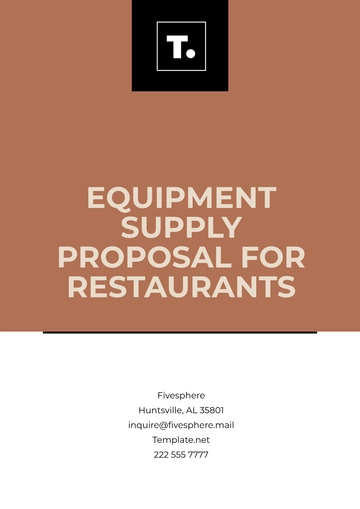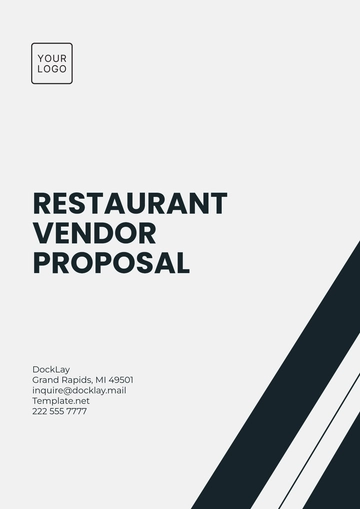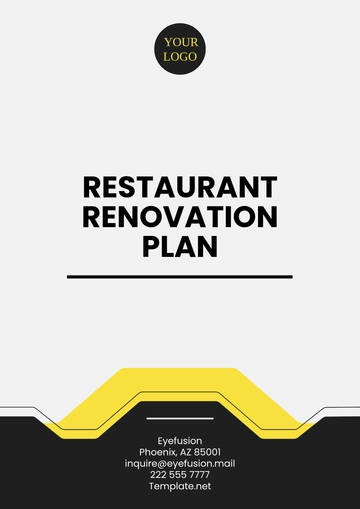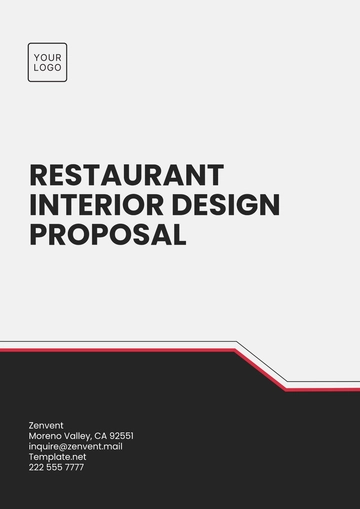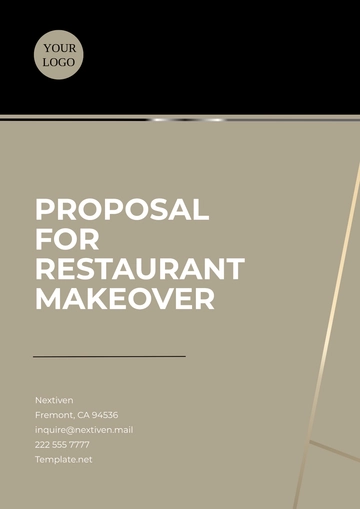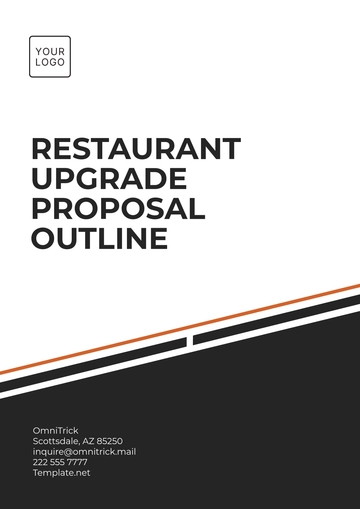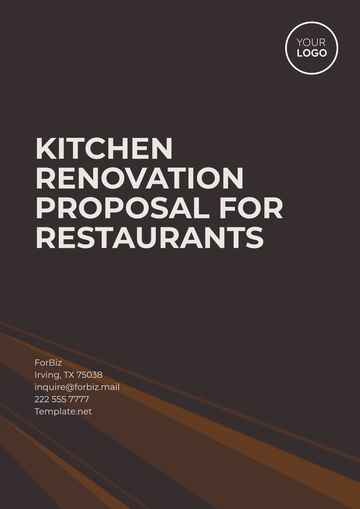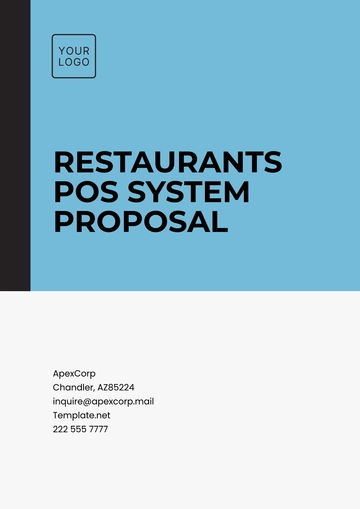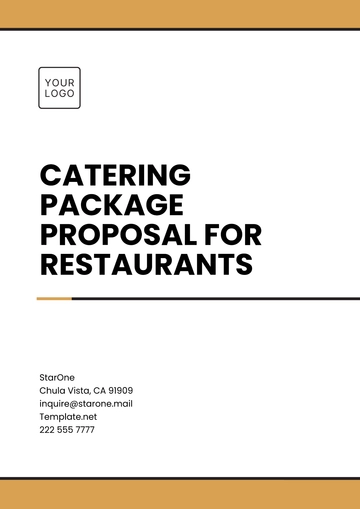Free Restaurant Advertising Proposal
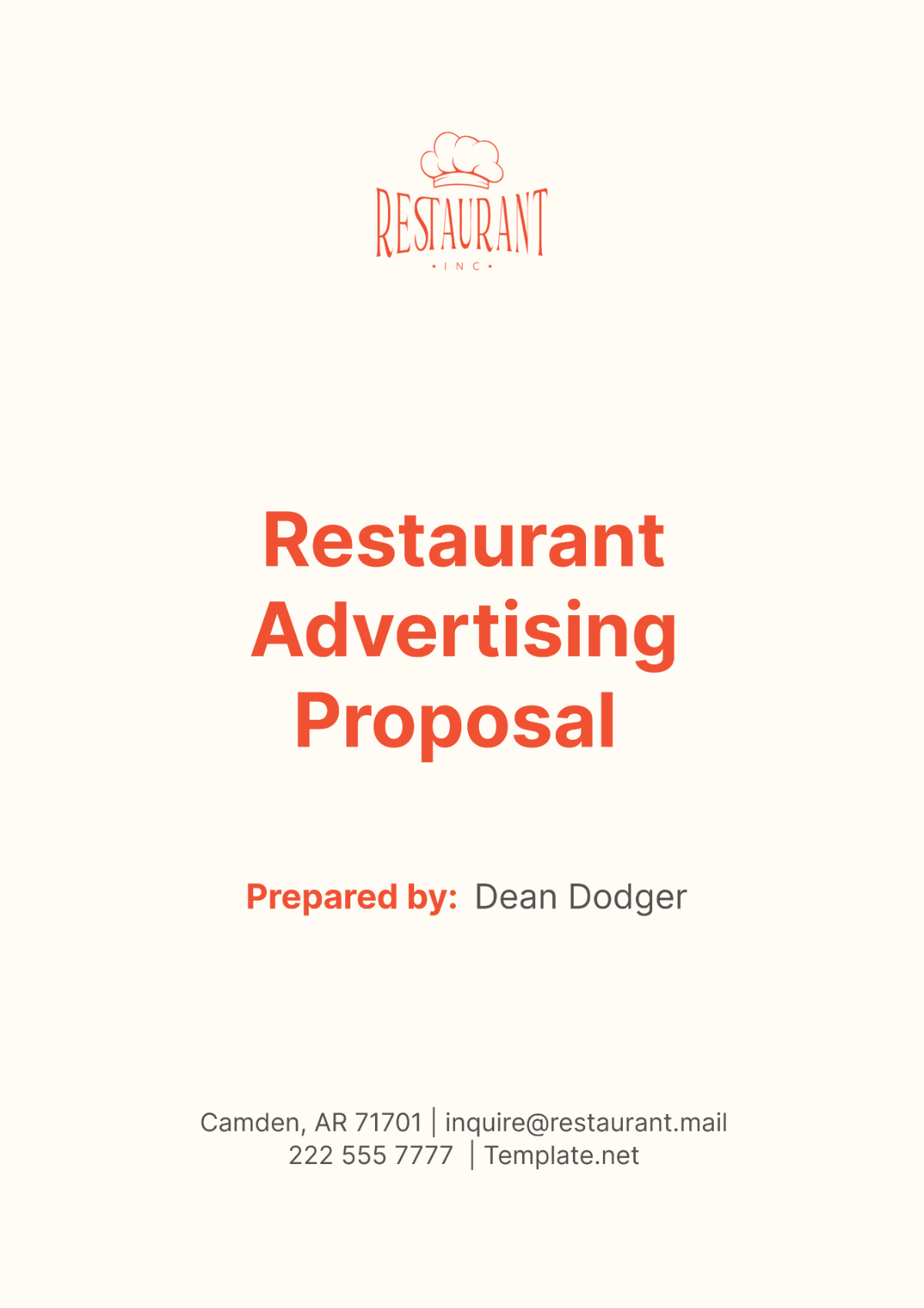
I. Executive Summary
This proposal presents a comprehensive advertising strategy for [Your Company Name]. Our strategy is meticulously designed, keeping in mind the unique identity of our restaurant and the competitive landscape of the market. We aim to create a compelling narrative that not only promotes the restaurant but also resonates with our target audience, thereby enhancing the restaurant’s brand image.
Our approach is rooted in a deep understanding of our target audience, their preferences, and their dining habits. We have clear and measurable campaign objectives that guide our efforts and ensure that our resources are utilized effectively. Our creative strategies are designed to engage the audience and create a buzz around the restaurant. We leverage various platforms and techniques, including digital advertising, social media campaigns, influencer collaborations, and content creation, to ensure maximum visibility and reach.
The total budget for this advertising campaign is $12,500. This budget has been carefully planned to ensure that each aspect of the campaign is adequately funded. The budget allocation takes into account the potential impact and return on investment of each activity, thereby ensuring that our efforts yield the best possible results. By strategically allocating our resources, we aim to create a high-impact advertising campaign that drives footfall to the restaurant and boosts its online presence.
II. Target Audience Insights
Our target audience is a vibrant mix of food enthusiasts aged between 25 and 45 years, who are located within a 20-mile radius of the restaurant. These individuals not only have a taste for good food but also an appetite for new culinary experiences. They fall into the mid-to-high income bracket, which enables them to frequently dine out and explore new cuisines.
Moreover, they are active on social media and enjoy sharing their dining experiences with their online community. This digital savviness of our target audience presents us with opportunities to engage with them on various social media platforms.
By understanding their preferences and habits, we can tailor our advertising approach to resonate with them, thereby ensuring maximum engagement and return on our advertising efforts. This deep understanding of our target audience forms the cornerstone of our advertising strategy. It allows us to create targeted and relevant advertising content that appeals to our audience and drives them to the restaurant.
III. Campaign Objectives
Our campaign objectives are designed to drive measurable outcomes that contribute to the overall success of our restaurant. These objectives serve as a roadmap for our advertising efforts, guiding us in allocating resources effectively and ensuring that our strategies align with the restaurant’s goals:
A. Increase Footfall
Our primary objective is to increase footfall by 30% over a period of six months. This involves attracting new customers and encouraging repeat visits from existing ones. We aim to achieve this through targeted advertising, special promotions, and by creating a dining experience that exceeds customer expectations.
B. Boost Social Media Followers
In today’s digital age, having a strong social media presence is crucial for any business. Therefore, our second objective is to boost the number of followers on our social media platforms by 25%. We plan to achieve this by regularly posting engaging content, running social media contests, and collaborating with influencers who can help us reach a larger audience.
C. Increase Online Engagement
Engaging with customers online is key to building strong relationships and fostering loyalty. Hence, our third objective is to increase online engagement by 40%. This includes encouraging customers to share their dining experiences on social media, responding promptly to comments and messages, and sharing behind-the-scenes content to give followers a glimpse into our restaurant’s operations.
IV. Creative Strategy
Our creative strategy is the heart of our advertising campaign. It revolves around storytelling, aiming to highlight the unique aspects of [Your Company Name], including its culinary offerings and ambiance.
A. Storytelling
Storytelling is a powerful tool that allows us to connect with our audience on a deeper level. By sharing the unique story of the restaurant, we can create a compelling narrative that resonates with our audience.
Origin Story: The origin story of [Your Company Name] is a great way to start our narrative. This includes sharing details about how the restaurant was started, the inspiration behind it, and the journey so far. This not only provides context but also helps build an emotional connection with the audience.
Unique Offerings: Highlighting the unique culinary offerings of our restaurant is crucial. This includes showcasing signature dishes, sharing the inspiration behind them, and explaining what makes them unique. High-quality images and engaging descriptions can make this content more appealing.
Ambiance: The ambiance plays a significant role in the dining experience. Sharing images and videos of the restaurant’s interior, along with descriptions of the atmosphere, can help the audience visualize their experience.
Testimonials: Sharing testimonials from satisfied customers can build trust and credibility. These testimonials can include quotes from customers, ratings, and reviews. They serve as social proof and can influence potential customers.
Behind the Scenes: Sharing behind-the-scenes content can provide a unique perspective. This includes showcasing the kitchen, introducing our staff, and sharing the process of preparing dishes. This type of content can make the audience feel more connected to the restaurant.
B. Digital Ads
Digital ads are a key component of our creative strategy. They allow us to reach a larger audience and drive traffic to both the restaurant and our social media platforms.
Search Engine Ads: Running ads on search engines can help us reach people who are actively looking for restaurants. These ads can be targeted based on keywords, location, and other factors.
Display Ads: Display ads can help us reach people while they’re browsing their favorite websites. These ads can include high-quality images and engaging copy to capture the audience’s attention.
Social Media Ads: Social media ads can help us reach a highly targeted audience. These ads can be tailored based on the audience’s interests, behaviors, and demographics.
Ad Optimization: Regular monitoring and optimization of our ads is crucial for their success. This includes analyzing performance metrics, testing different ad variations, and making necessary adjustments.
C. Social Media Promotions
Social media promotions are an effective way to engage with our audience and build a strong online presence. They allow us to share engaging content, interact with our audience, and increase our reach.
Regular Posting: Regularly posting engaging content on our social media platforms is crucial for keeping our audience interested and engaged. This includes sharing updates, photos, videos, and other relevant content.
Contests and Giveaways: Running contests and giveaways can encourage user participation and increase engagement. They can also help us gain new followers and increase our reach.
User-Generated Content: Encouraging users to share their own experiences at the restaurant can provide authentic content for our platforms. This includes sharing photos, reviews, and other user-generated content.
Influencer Collaborations: Collaborating with influencers can help us reach a larger audience. This includes sponsored posts, influencer reviews, and other types of collaborations.
Community Management: Responding to comments, messages, and reviews on our social media platforms is crucial for building relationships with our audience. This includes answering questions, addressing concerns, and showing appreciation for positive feedback.
D. Influencer Collaborations
Influencer collaborations can help us reach a larger audience and build credibility. By partnering with influencers who resonate with our target audience, we can create authentic and engaging content.
Identifying Influencers: The first step in influencer collaborations is identifying the right influencers. This includes looking at their audience, engagement rates, and the type of content they share.
Sponsored Posts: Sponsored posts are a common type of influencer collaboration. This includes having the influencer share posts about their experience at the restaurant.
Influencer Reviews: Having influencers review the restaurant can provide authentic and trustworthy content. These reviews can be shared on the influencer’s platform as well as our own.
Giveaways: Collaborating with influencers for giveaways can increase engagement and reach. This includes having the influencer host a giveaway where their followers have a chance to win a meal at the restaurant.
Long-Term Partnerships: Building long-term partnerships with influencers can provide ongoing benefits. This includes regular collaborations, co-created content, and other joint efforts.
Performance Tracking: Tracking the performance of our influencer collaborations is crucial for understanding their impact. This includes looking at metrics like reach, engagement, and conversions. Based on these insights, we can optimize our influencer strategy.
V. Budget Breakdown
A well-planned budget is crucial for the success of any advertising campaign. It ensures that resources are allocated effectively across various activities, allowing us to maximize the impact of our efforts. The following chart and table provide the detailed breakdown of the estimated costs for each activity in our advertising campaign:
Activity | Estimated Cost |
|---|---|
Digital Advertising | $5,000 |
Social Media Campaigns | $3,000 |
Influencer Collaborations | $2,000 |
Content Creation | $1,500 |
Print Media | $1,000 |
Total | $12,500 |
A. Digital Advertising
Digital advertising, with an allocation of $5,000, forms a significant part of our budget. This includes running targeted ads on search engines and social media platforms. The aim is to reach a larger audience and drive traffic to both the restaurant and our social media platforms. By investing in digital advertising, we can ensure that our restaurant reaches the screens of potential customers, thereby increasing visibility and attracting more patrons.
B. Social Media Campaigns
Social media campaigns, with a budget of $3,000, are crucial for building a strong online presence. Regularly posting engaging content, running contests, and collaborating with influencers are some of the activities planned under this. Social media platforms provide a space for us to interact directly with our audience, understand their preferences, and tailor our services accordingly.
C. Influencer Collaborations
Influencer collaborations, with a budget of $2,000, offer a unique opportunity to reach out to a larger audience and build credibility. Influencers can help us create authentic and engaging content, and their endorsement can significantly boost the restaurant’s image. This strategy not only helps in increasing our customer base but also enhances our brand reputation.
D. Content Creation
Content creation, with a budget of $1,500, is essential for our storytelling approach. High-quality images, engaging videos, and compelling copy can highlight the unique aspects of the restaurant and create a narrative that resonates with our audience. Good content can captivate potential customers, encouraging them to learn more about our offerings and ultimately visit the restaurant.
E. Print Media
Print media, with a budget of $1,000, is a traditional yet effective way to reach certain segments of our audience. Despite the digital age, print media like local newspapers and magazines still have a wide reach and can help us connect with potential customers who prefer traditional media channels.
F. Total
The total budget for our advertising campaign is $12,500. This budget has been carefully planned to ensure that each activity receives adequate funding, thereby maximizing the effectiveness of our campaign. By allocating our resources wisely, we can ensure that our advertising efforts yield the best possible results.
The budget breakdown not only provides a clear picture of how funds are allocated but also ensures that every aspect of the advertising campaign is adequately funded. It’s important to remember that each component of the campaign, from digital advertising to content creation, plays a vital role in promoting the restaurant and attracting customers. Therefore, a well-planned budget is not just about spending money wisely, but also about ensuring that each dollar spent contributes to achieving our campaign objectives.
Moreover, having a detailed budget breakdown allows us to track our spending and measure the return on investment for each activity. This can provide valuable insights into which activities are most effective and where adjustments may be needed. In this way, the budget is not just a financial plan, but also a strategic tool that can guide our advertising efforts and help us achieve our goals.
VI. Analytics Plan
To ensure the effectiveness of our advertising campaign, we will utilize various analytics tools. These tools will allow us to track and measure the performance of our campaign, providing valuable insights that can guide our efforts and help us achieve our objectives:
A. Google Analytics
Google Analytics is a powerful tool that allows us to track website traffic and understand how users are interacting with our website. This can provide valuable insights into user behavior and preferences, helping us tailor our approach for maximum engagement.
Website Traffic: One of the key metrics we will track is website traffic. This includes the number of visitors to our website, the pages they visit, and the duration of their visit. This information can help us understand which aspects of our website are most appealing to our audience.
Bounce Rate: The bounce rate is the percentage of visitors who leave our website after viewing only one page. A high bounce rate could indicate that our website is not engaging enough or that it does not meet the expectations of our visitors.
Average Session Duration: The average session duration is the average amount of time that visitors spend on our website. This metric can provide insights into how engaging our website is and whether our content is effectively holding the attention of our visitors.
Conversion Rate: The conversion rate is the percentage of visitors who complete a desired action on our website, such as making a reservation or signing up for a newsletter. This metric is crucial for understanding the effectiveness of our call-to-action elements.
Traffic Sources: Understanding where our traffic is coming from can help us optimize our advertising efforts. This includes tracking referrals from other websites, traffic from search engines, and visits from social media platforms.
B. Social Media Analytics
Social media analytics will allow us to monitor engagement rates on our social media platforms. This includes tracking likes, shares, comments, and follower growth. By understanding these metrics, we can tailor our social media strategy to maximize engagement and reach.
Engagement Rate: The engagement rate is the percentage of our followers who interact with our posts. This includes likes, comments, and shares. A high engagement rate indicates that our content is resonating with our audience.
Follower Growth: Tracking our follower growth can provide insights into the effectiveness of our social media strategy. A steady increase in followers indicates that our content is appealing and that our reach is expanding.
Post Reach: Post reach is the number of unique users who have seen our posts. This metric can help us understand how far our content is spreading beyond our immediate followers.
Top Performing Posts: Identifying our top performing posts can provide insights into what type of content our audience finds most engaging. This can guide our content creation efforts and help us create more of what our audience loves.
C. CRM Tools
Customer Relationship Management (CRM) tools will allow us to measure customer retention and understand customer behavior. This includes tracking repeat visits, average spend, and customer feedback. By understanding these metrics, we can tailor our services to meet the needs and preferences of our customers.
Customer Retention Rate: The customer retention rate is the percentage of customers who return to the restaurant. A high retention rate indicates that our customers are satisfied with their dining experience and are likely to return.
Average Spend: The average spend is the average amount that customers spend at the restaurant. This metric can provide insights into the spending habits of our customers and help us optimize our pricing strategy.
Customer Feedback: Collecting and analyzing customer feedback can provide valuable insights into what our customers like and dislike about their dining experience. This can guide our efforts to improve our services and enhance customer satisfaction.
Customer Segmentation: Customer segmentation involves dividing our customer base into groups based on characteristics such as dining preferences, spending habits, and frequency of visits. This can help us tailor our advertising efforts to the needs and preferences of each segment.
Sales Funnel Analysis: Sales funnel analysis involves tracking the journey of our customers from the moment they first hear about our restaurant to the moment they make a reservation. This can provide insights into which stages of the journey are most effective and where improvements can be made.
Campaign Performance: Tracking the performance of our advertising campaigns can provide insights into their effectiveness. This includes tracking metrics such as reach, engagement, and conversions. Based on these insights, we can optimize our campaigns to maximize their impact.
VII. Timeline
A well-structured timeline is crucial for the successful execution of our advertising campaign. It ensures that each phase of the campaign is carried out in a timely manner, allowing us to maintain momentum and achieve our objectives. The following table outlines the timeline for our advertising campaign:
Phase | Duration | Activities |
|---|---|---|
Research & Planning | 2 weeks | Market research, target audience analysis |
Content Creation | 3 weeks | Developing ad creatives and content |
Campaign Launch | 1 week | Deploying ads and initiating social media push |
Monitoring & Optimization | 6 months | Tracking performance, making adjustments |
Final Evaluation | 1 week | Assessing overall effectiveness |
A. Research & Planning
The first phase of our campaign, lasting two weeks, involves conducting market research and analyzing our target audience. This phase is crucial for understanding the market landscape, identifying our target audience’s preferences, and planning our campaign strategy. By investing time in research and planning, we can ensure that our campaign is well-targeted and effective.
B. Content Creation
The second phase, lasting three weeks, involves developing ad creatives and content. This includes creating engaging copy, high-quality images, and compelling videos that highlight the unique aspects of the restaurant. By focusing on content creation, we can ensure that our campaign resonates with our audience and effectively communicates our message.
C. Campaign Launch
The third phase, lasting one week, involves deploying our ads and initiating our social media push. This includes launching our digital ads, posting our content on social media, and starting our influencer collaborations. The campaign launch is a critical phase as it sets the tone for the rest of the campaign.
D. Monitoring & Optimization
The fourth phase, lasting six months, involves tracking the performance of our campaign and making necessary adjustments. This includes monitoring our analytics, evaluating the effectiveness of our ads, and optimizing our strategy based on our findings. By regularly monitoring and optimizing our campaign, we can ensure that it continues to perform well and achieve our objectives.
E. Final Evaluation
The final phase, lasting one week, involves assessing the overall effectiveness of our campaign. This includes evaluating whether we have met our objectives, analyzing the return on our investment, and gathering insights for future campaigns. The final evaluation allows us to reflect on our campaign and learn from our experiences.
The timeline provides a clear roadmap for our advertising campaign, ensuring that each phase is carried out in a timely and efficient manner. It allows us to plan our resources effectively, maintain momentum throughout the campaign, and achieve our objectives.
Additionally, this detailed timeline allows us to track our progress and make necessary adjustments along the way. It ensures that we stay focused on our objectives and that each phase of the campaign contributes towards achieving these objectives. In this way, the timeline is not just a schedule, but also a strategic tool that guides our advertising efforts and drives the success of our campaign.
VIII. Recommendations
These recommendations are designed to complement our advertising strategy and provide additional avenues for promoting the restaurant:
A. High-Impact Visuals
Visual content plays a crucial role in capturing the audience’s attention and conveying our message effectively. Therefore, we recommend the following:
Quality Images: Use high-quality images in our ads and social media posts. These images should highlight the restaurant’s ambiance and culinary offerings, enticing potential customers to visit.
Engaging Videos: Create engaging videos that provide a glimpse into the restaurant’s operations. This could include behind-the-scenes footage, chef interviews, or customer testimonials.
Consistent Branding: Ensure that all visual content aligns with the restaurant’s branding. This includes using consistent colors, fonts, and styles across all platforms.
User-Generated Content: Encourage customers to share their own photos and videos of their dining experiences. This not only provides authentic content for our platforms but also increases engagement.
Influencer Content: Leverage the content created by influencers during our collaborations. This content can reach a larger audience and provide a fresh perspective on the restaurant.
B. Regular Social Media Updates
Regular updates on social media platforms can keep our audience engaged and informed. Therefore, we recommend the following:
Content Calendar: Develop a content calendar to plan our social media posts in advance. This ensures that we have a steady stream of content and can schedule posts for optimal times.
Diverse Content: Post a variety of content to keep our audience interested. This could include updates, promotions, behind-the-scenes footage, customer testimonials, and more.
Engagement: Engage with our audience by responding to comments, answering questions, and acknowledging feedback. This can build relationships and foster a sense of community.
Promotions: Run regular promotions or contests on our social media platforms. This can increase engagement and attract new followers.
C. Influencer Collaborations
Influencer collaborations can extend our reach and provide authentic promotion. Therefore, we recommend the following:
Identify Relevant Influencers: Collaborate with influencers who resonate with our target audience. Their endorsement can significantly boost the restaurant’s image.
Sponsored Posts: Arrange for sponsored posts where the influencer shares their dining experience at the restaurant. This can provide authentic and engaging content for our audience.
Influencer Reviews: Invite influencers to review the restaurant. Their reviews can provide an unbiased perspective and attract their followers to the restaurant.
Long-Term Partnerships: Consider establishing long-term partnerships with influencers. This can lead to ongoing promotion and a stronger relationship with the influencer’s audience.
Track Performance: Monitor the performance of our influencer collaborations. This can provide insights into their effectiveness and guide our future influencer strategy.
D. Routine Monitoring and Optimization
Routine monitoring and optimization can ensure that our campaign continues to perform well and achieve our objectives. Therefore, we recommend the following:
Analytics: Regularly review our analytics to track the performance of our campaign. This includes website traffic, social media engagement, and customer retention.
Adjustments: Make necessary adjustments based on our analytics. This could include tweaking our ads, posting at different times, or collaborating with different influencers.
A/B Testing: Conduct A/B testing to determine the most effective strategies. This involves comparing two versions of an ad or post to see which performs better.
Feedback: Listen to feedback from our audience and incorporate it into our strategy. This can help us meet the needs and preferences of our audience more effectively.
IX. Conclusion
This advertising proposal presents a comprehensive and strategic plan to enhance the brand visibility of [Your Company Name], drive foot traffic, and foster online engagement. Our approach is rooted in a deep understanding of our target audience, their preferences, and dining habits. We have leveraged this understanding to craft a compelling narrative that not only promotes our restaurant but also resonates with the audience.
Our strategy encompasses various elements, including digital advertising, social media campaigns, influencer collaborations, and content creation, all of which are designed to work in synergy to achieve our campaign objectives. With a clear timeline and budget, [Your Company Name] is poised to deliver a successful advertising campaign that not only meets but exceeds expectations.
- 100% Customizable, free editor
- Access 1 Million+ Templates, photo’s & graphics
- Download or share as a template
- Click and replace photos, graphics, text, backgrounds
- Resize, crop, AI write & more
- Access advanced editor
Create compelling advertising campaigns with the Restaurant Advertising Proposal Template from Template.net! This editable template helps you outline advertising strategies clearly. Customize the proposal to suit your restaurant’s branding and objectives using the customizable options. The AI Editor Tool assists in crafting persuasive proposals in just a few easy clicks!
You may also like
- Business Proposal
- Research Proposal
- Proposal Request
- Project Proposal
- Grant Proposal
- Photography Proposal
- Job Proposal
- Budget Proposal
- Marketing Proposal
- Branding Proposal
- Advertising Proposal
- Sales Proposal
- Startup Proposal
- Event Proposal
- Creative Proposal
- Restaurant Proposal
- Blank Proposal
- One Page Proposal
- Proposal Report
- IT Proposal
- Non Profit Proposal
- Training Proposal
- Construction Proposal
- School Proposal
- Cleaning Proposal
- Contract Proposal
- HR Proposal
- Travel Agency Proposal
- Small Business Proposal
- Investment Proposal
- Bid Proposal
- Retail Business Proposal
- Sponsorship Proposal
- Academic Proposal
- Partnership Proposal
- Work Proposal
- Agency Proposal
- University Proposal
- Accounting Proposal
- Real Estate Proposal
- Hotel Proposal
- Product Proposal
- Advertising Agency Proposal
- Development Proposal
- Loan Proposal
- Website Proposal
- Nursing Home Proposal
- Financial Proposal
- Salon Proposal
- Freelancer Proposal
- Funding Proposal
- Work from Home Proposal
- Company Proposal
- Consulting Proposal
- Educational Proposal
- Construction Bid Proposal
- Interior Design Proposal
- New Product Proposal
- Sports Proposal
- Corporate Proposal
- Food Proposal
- Property Proposal
- Maintenance Proposal
- Purchase Proposal
- Rental Proposal
- Recruitment Proposal
- Social Media Proposal
- Travel Proposal
- Trip Proposal
- Software Proposal
- Conference Proposal
- Graphic Design Proposal
- Law Firm Proposal
- Medical Proposal
- Music Proposal
- Pricing Proposal
- SEO Proposal
- Strategy Proposal
- Technical Proposal
- Coaching Proposal
- Ecommerce Proposal
- Fundraising Proposal
- Landscaping Proposal
- Charity Proposal
- Contractor Proposal
- Exhibition Proposal
- Art Proposal
- Mobile Proposal
- Equipment Proposal
- Student Proposal
- Engineering Proposal
- Business Proposal

